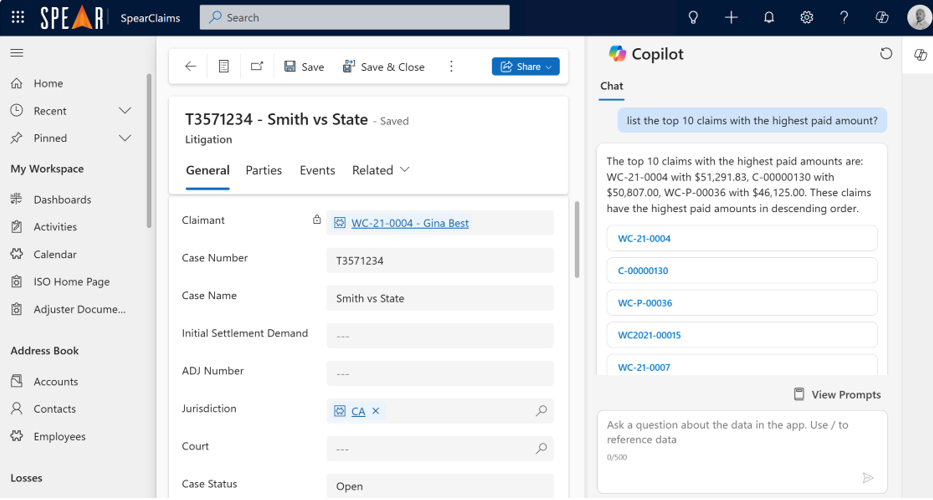Evaluating Claims Management Software
This buyer’s guide is designed to help you identify what to look for in modern claims management software and avoid common pitfalls during the selection process.
As insurance organizations evolve, so do their expectations for technology. Legacy claims management software systems often fail to meet today’s need for automation, visibility, and speed. Whether you’re a carrier looking to modernize, a TPA serving multiple clients, a public entity managing complex claims, a risk pool tracking collective exposure, or a self-insured organization focused on cost control—the right claims management system can make all the difference.
The Evolving Landscape of Claims Management
The claims process has become more than just paying losses. It now includes data analysis, customer experience, vendor coordination, litigation management, and compliance oversight. And with the rise of low-code/no-code insurance platforms, organizations now have powerful options to customize systems without traditional development cycles.
Tailored Needs from Claims Management Software by Organization Type
Carriers
- Scalability for multiple lines of business
- Integration with policy admin, billing, and reinsurance systems
- Compliance automation for state and federal requirements
Third-Party Administrators
- Multi-client configuration with unique rules/workflows
- White-label capabilities and flexible client reporting
- Efficient intake and triage tools
Public Entities
- Governmental reporting capabilities
- Long-tail exposure tracking
- Internal communication & audit trails for transparency
Risk Pools
- Collective risk tracking and allocation tools
- Member-specific dashboards and performance metrics
- Integrated subrogation and recovery tools
Self-Insured Organizations
- Recurring claims management (e.g., workers’ comp, health)
- Vendor and legal spend control
- Automation of FNOL and follow-up task
5 Must-Have Features in Modern Claims Management Software
Next-generation claims management software with Accessible AI empowers your business users to quickly add new business rules, adjust rating algorithms, add new data fields, re-arrange fields, and even extend the system with in-house built capabilities. Insist on Accessible AI during your claims management software evaluation.
Red Flags to Avoid
Legacy systems with outdate technology that require the vendor to make to make even minor changes, excessive implementation times and hidden fees are all big red flags when performing claims management software evaluation.
The Bottom Line: Flexibility and Speed Are Now Mandatory
The future of claims management lies in platforms that are:
- Agile
- Scalable
- Configurable by business users
- Built on low-code/no-code frameworks
Whether you’re upgrading from spreadsheets or replacing legacy systems, choose a claims management software solution that evolves with your needs and empowers every stakeholder.
20 Questions to Ask Before Choosing a Claims Management System
Use this checklist to guide internal discussions and vendor demos during your claims management software evaluation:
-
Does the system support our specific lines of business and claim types (e.g., liability, workers’ comp, property)?
-
Can business users configure workflows, rules, and forms without relying on developers?
-
How quickly can we launch a new client, program, or line of business using this platform?
-
What third-party data integrations (e.g., ISO, CMS, VIN, address validation) are prebuilt or available via API?
-
Can the system provide client/member-specific dashboards and reporting views out of the box?
-
Is there a mobile-optimized or responsive experience for adjusters, claimants, and supervisors?
-
What kind of embedded reporting and analytics tools are included (dashboards, KPIs, export options)?
-
Can the platform track litigation milestones, legal expenses, and associated parties easily?
-
Will we retain full ownership and unrestricted access to our data?
-
Are audit trails and internal notes preserved automatically for every user action?
-
Does the system support secure, role-based access and permissioning for all user types?
-
Can we customize letters, emails, and communication templates without IT involvement?
-
Will business users be empowered to make real-time changes to workflows and business rules without needing vendor assistance?
-
How are system updates, feature enhancements, and bug fixes managed—and are they disruptive?
-
Does the solution include tools for vendor tracking, payment management, and invoice reconciliation?
-
Is native document generation (e.g., letters, reports, forms) available and customizable?
-
Can the system integrate easily with our current policy, billing, or general ledger systems via API or connectors?
-
What service-level agreements (SLAs) are offered for uptime, performance, and support response times?
-
What is the typical implementation timeline—from contract to go-live—for an organization of our size?
-
Are end-user training, administrator onboarding, and post-launch support included in the package?
Discover a smarter way to manage claims.
Schedule a Demo to see first-hand how SpearClaims™ will enable your organization to accelerate and simplify claims processing. Built by industry experts on a modern low-code/no-code platform, SpearClaims™ is a future-ready claims management software solution delivering the power of next-generation AI capabilities – all the “must-haves” with none of the red flags.
To discover how Spear’s solutions are accessible to insurers of all sizes, Request Pricing.
Harford County Goes Live with SpearClaims™
SpearClaims™
A modern claims management software solution designed specifically for property and casualty insurance management.
Request Pricing
Fill out and submit the form below and we'll follow-up with you.
Book a Demo
Fill out and submit the form below and we'll follow-up with you to book a demonstration of our innovative insurance software solutions!

